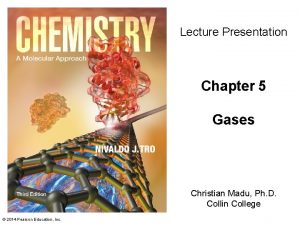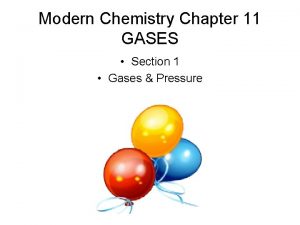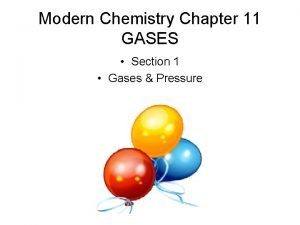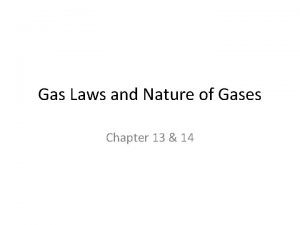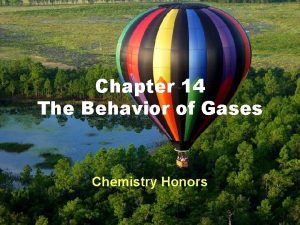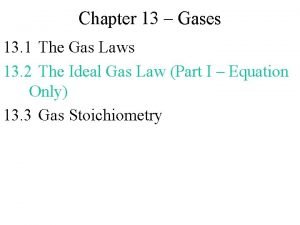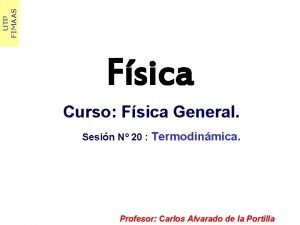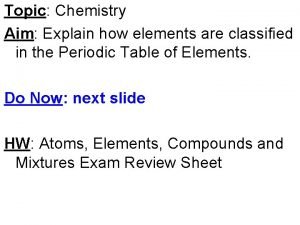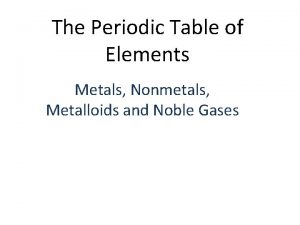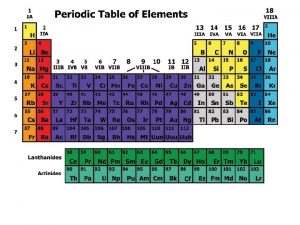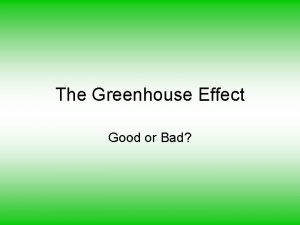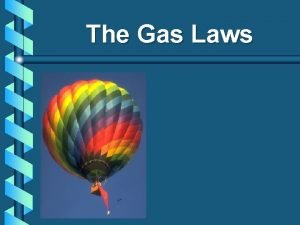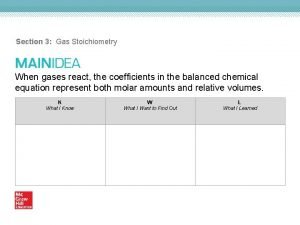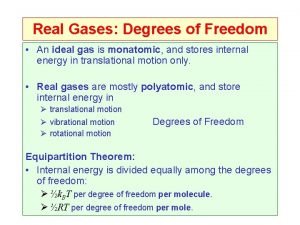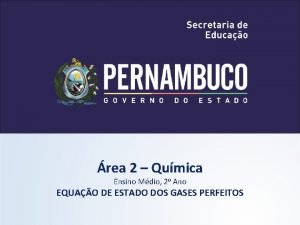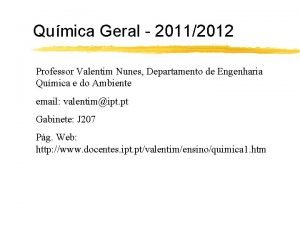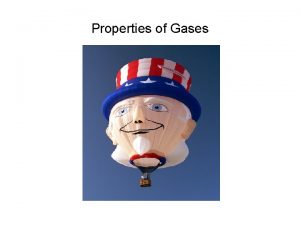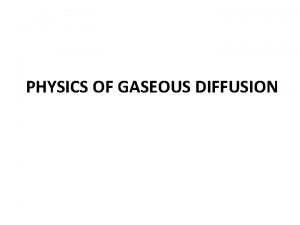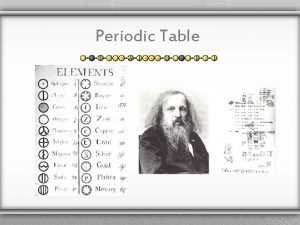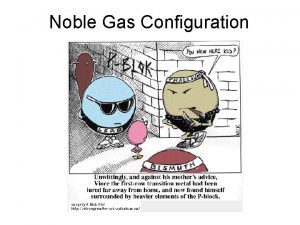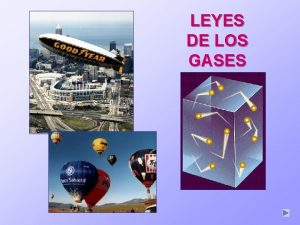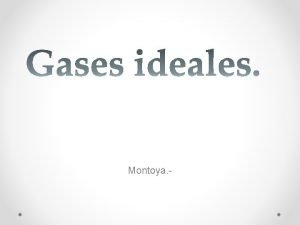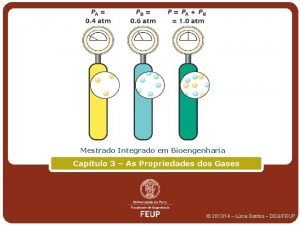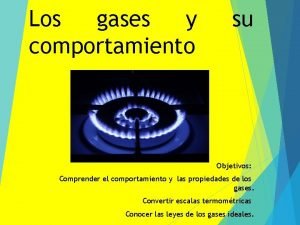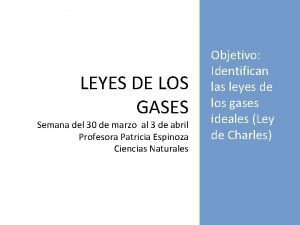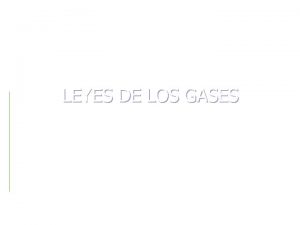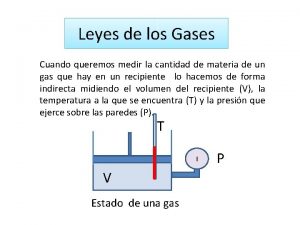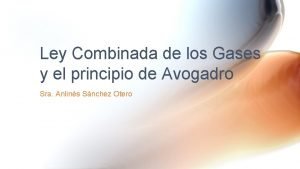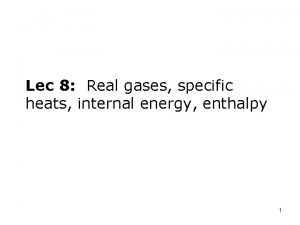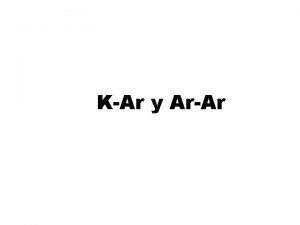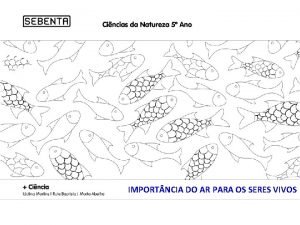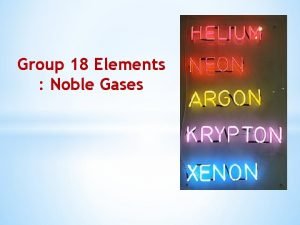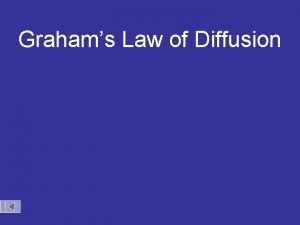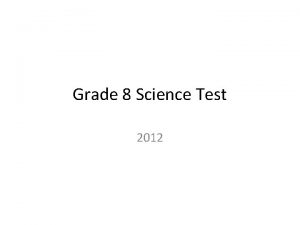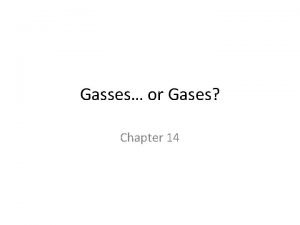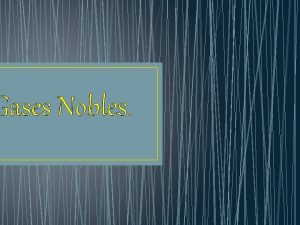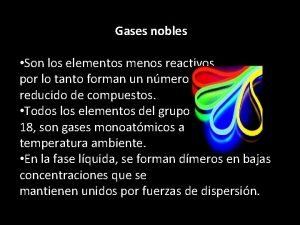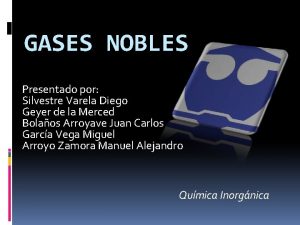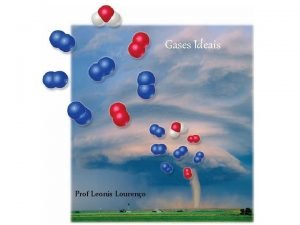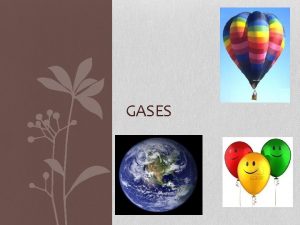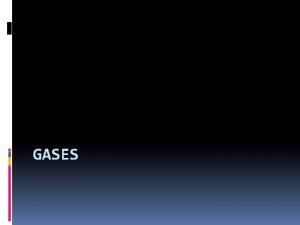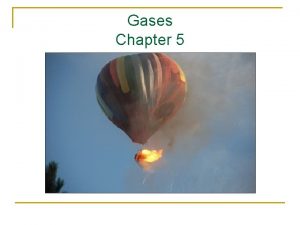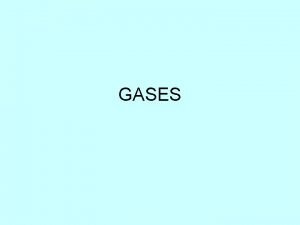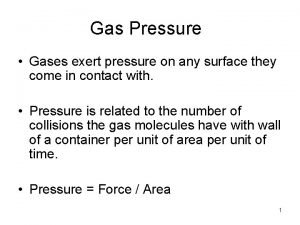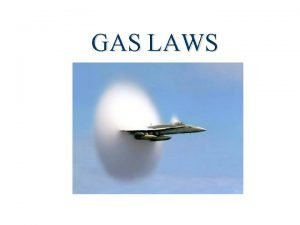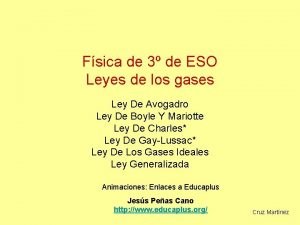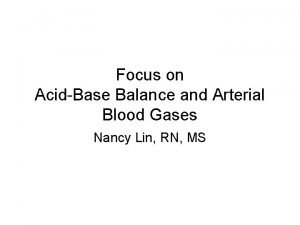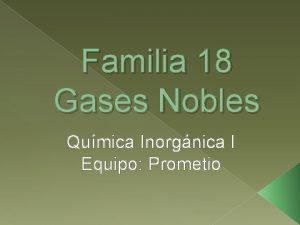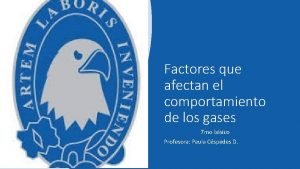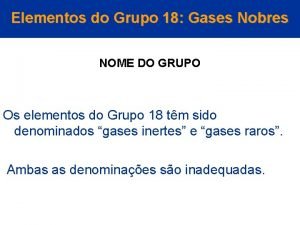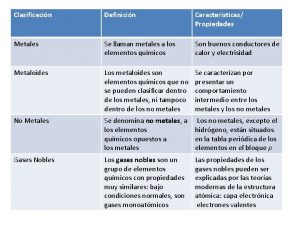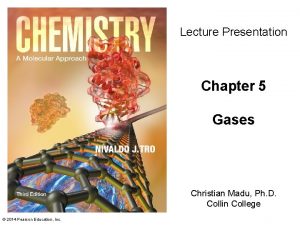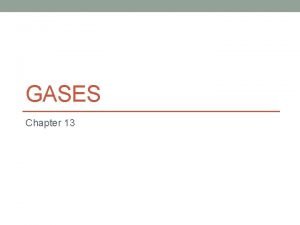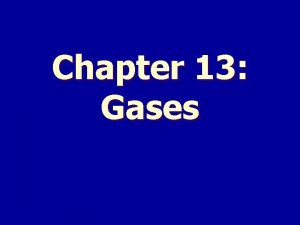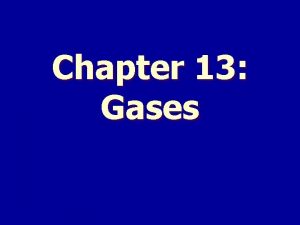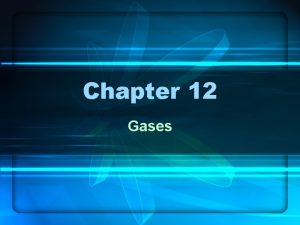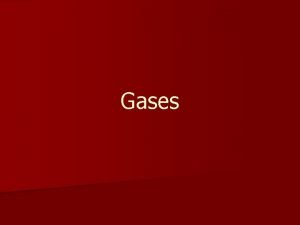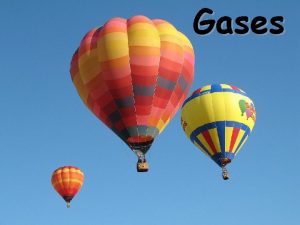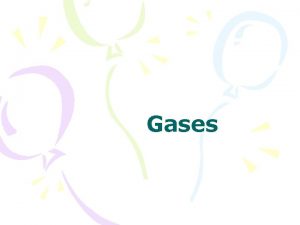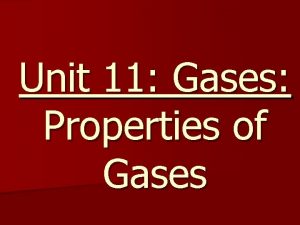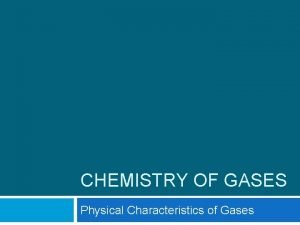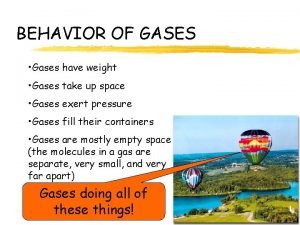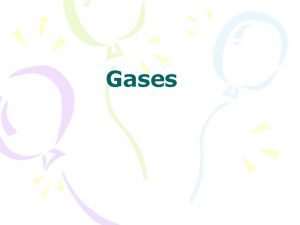Lecture Presentation Chapter 5 Gases Christian Madu Ph









































































- Slides: 73

Lecture Presentation Chapter 5 Gases Christian Madu, Ph. D. Collin College © 2014 Pearson Education, Inc.

Gas • Gases are composed of particles that are moving around very fast in their container(s). • These particles moves in straight lines until they collides with either the container wall or another particle, then they bounce off. • A snapshot of these particles in a gas, will reveal that there is a lot of empty space in there. © 2014 Pearson Education, Inc.

Gas Pressure • Just as a ball exerts a force when it bounces against a wall, a gaseous atom or molecule exerts a force when it collides with a surface. • The result of many of these molecular collisions is pressure. • Pressure is the force exerted per unit area by gas molecules as they strike the surfaces around them. © 2014 Pearson Education, Inc.

Gas Pressure • Gas pressure is a result of the constant movement of the gas molecules and their collisions with the surfaces around them. • The pressure of a gas depends on several factors: ü Number of gas particles in a given volume ü Volume of the container ü Average speed of the gas particles © 2014 Pearson Education, Inc.

Gas Pressure • The total pressure exerted by a gas depends on several factors, including the concentration of gas molecules in the sample. üThe higher the concentration, the greater the pressure. • As volume increases, concentration of gas molecules decreases (number of molecules does not change, but since the volume increases, the concentration goes down). üThis in turn results in fewer molecular collisions, which results in lower pressure. © 2014 Pearson Education, Inc.

• Pressure exerted by a gas is dependent on the number of gas particles in a given volume. • The fewer the gas particles, the lower the force per unit area and the lower the pressure. ü A low density of gas particles results in low pressure. A high density of gas particles results in high pressure. © 2014 Pearson Education, Inc.

The Manometer • The pressure of a gas trapped in a container can be measured with an instrument called a manometer. • Manometers are U-shaped tubes partially filled with a liquid that are connected to the gas sample on one side and open to the air on the other. • A competition is established between the pressures of the atmosphere and the gas. • The difference in the liquid levels is a measure of the difference in pressure between the gas and the atmosphere. © 2014 Pearson Education, Inc.

The Manometer For this sample the gas pressure is greater than atmospheric pressure, the mercury level on the left side of the tube is higher than the level on the right. © 2014 Pearson Education, Inc.

The Simple Gas Laws • Boyle’s Law • Charles’s Law • Avogadro’s Law • There are four basic properties of a gas: pressure (P), volume (V), temperature (T), and amount in moles (n). üThese properties are interrelated—when one changes, it affects the others. üThe simple gas laws describe the relationships between pairs of these properties. © 2014 Pearson Education, Inc.

Boyle’s Law: Robert Boyle (1627– 1691) • Robert Boyle and Robert Hooke used a J-tube to measure the volume of a sample of gas at different pressures. • They trapped a sample of air in the J-tube and added mercury to increase the pressure on the gas. üThey observed an inverse relationship between volume and pressure. üHence, an increase in one causes a decrease in the other. © 2014 Pearson Education, Inc.

Boyle’s Law © 2014 Pearson Education, Inc.

Boyle’s Law • Pressure of a gas is inversely proportional to its • • • volume. üConstant T and amount of gas üGraph P vs. V is curve üGraph P vs. 1/V is straight line As P increases, V decreases by the same factor. P × V = constant P 1 × V 1 = P 2 × V 2 © 2014 Pearson Education, Inc.

Molecular Interpretation of Boyle’s Law As the volume of a gas sample is decreased, gas molecules collide with surrounding surfaces more frequently, resulting in greater pressure. © 2014 Pearson Education, Inc.

Charles’s Law: Volume and Temperature • The volume of a fixed amount of gas at a constant pressure increases linearly with increasing temperature in kelvins: üThe volume of a gas increases with increasing temperature. • Kelvin T = Celsius T + 273 • V = constant × T (if T measured in Kelvin) © 2014 Pearson Education, Inc.

Charles’s Law If the lines are extrapolated back to a volume of “ 0, ” they all show the same temperature, − 273. 15 °C = 0 K, called absolute zero The extrapolated lines cannot be measured experimentally because all gases condense into liquids before – 273. 15 °C is reached. © 2014 Pearson Education, Inc.

Charles’s Law – A Molecular View If we move a balloon from an ice water bath to a boiling water bath, its volume expands as the gas particles within the balloon move faster (due to the increased temperature) and collectively occupy more space. © 2014 Pearson Education, Inc.

Charles’s Law – A Molecular View • When the temperature of a gas sample increases, the gas particles move faster. üCollisions with the walls are more frequent. üThe force exerted with each collision is greater. • The only way for the pressure (the force per unit area) to remain constant is for the gas to occupy a larger volume so that collisions become less frequent and occur over a larger area. © 2014 Pearson Education, Inc.

Charles’s Law © 2014 Pearson Education, Inc.

Avogadro’s Law, Amedeo Avogadro (1776– 1856) • Volume directly proportional to the number of gas molecules ü V = constant × n ü Constant P and T ü More gas molecules = larger volume • Count number of gas molecules by moles. • Equal volumes of gases contain equal numbers of molecules. ü The gas doesn't matter. © 2014 Pearson Education, Inc.

Avogadro’s Law When the amount of gas in a sample increases at constant temperature and pressure, its volume increases in direct proportion because the greater number of gas particles fill more space. The volume of a gas sample increases linearly with the number of moles of gas in the sample. © 2014 Pearson Education, Inc.

Ideal Gas Law • The relationships that we have discussed so far can be combined into a single law that encompasses all of them. © 2014 Pearson Education, Inc.

Ideal Gas Law · By combining the gas laws we can write a general equation. · R is called the gas constant. · The value of R depends on the units of P and V. üWe will use to liters. and convert P to atm and V · The other gas laws are found in the ideal gas law if two variables are kept constant. · The ideal gas law allows us to find one of the variables if we know the other three. © 2014 Pearson Education, Inc.

Ideal Gas Law © 2014 Pearson Education, Inc.

Standard Conditions • Because the volume of a gas varies with pressure and temperature, chemists have agreed on a set of conditions to report our measurements so that comparison is easy. üWe call these standard conditions. üSTP • Standard pressure = 1 atm • Standard temperature = 273 K = 0 °C © 2014 Pearson Education, Inc.

Molar Volume • The volume occupied by one mole of a substance is its molar volume at STP (T =273 K or 0 °C and P = 1 atm). © 2014 Pearson Education, Inc.

Molar Volume at STP • Solving the ideal gas equation for the volume of 1 mol of gas at STP gives 22. 4 L. ü 6. 022 × 1023 molecules of gas üNotice that the gas is immaterial. • We call the volume of 1 mole of gas at STP the molar volume. üIt is important to recognize that one mole measure of different gases have different masses, even though they have the same volume. © 2014 Pearson Education, Inc.

Molar Volume at STP © 2014 Pearson Education, Inc.

Density of a Gas at STP • • Density is the ratio of mass to volume. Density of a gas is generally given in g/L. The mass of 1 mole = molar mass. The volume of 1 mole at STP = 22. 4 L. © 2014 Pearson Education, Inc.

Density of a Gas at STP • For example, the densities of helium and nitrogen gas at STP are as follows: © 2014 Pearson Education, Inc.

Gas Density • Density is directly proportional to molar mass. © 2014 Pearson Education, Inc.

Molar Mass of a Gas • One of the methods chemists use to determine the molar mass of an unknown substance is to heat a weighed sample until it becomes a gas; measure the temperature, pressure, and volume; and use the ideal gas law. © 2014 Pearson Education, Inc.

Mixtures of Gases • Many gas samples are not pure, but are mixtures of gases. • Dry air, for example, is a mixture containing nitrogen, oxygen, argon, carbon dioxide, and a few other gases in trace amounts. © 2014 Pearson Education, Inc.

Mixtures of Gases • Therefore, in certain applications, the mixture can be thought of as one gas. üEven though air is a mixture, we can measure the pressure, volume, and temperature of air as if it were a pure substance. üWe can calculate the total moles of molecules in an air sample, knowing P, V, and T, even though they are different molecules. © 2014 Pearson Education, Inc.

Partial Pressure • The pressure of a single gas in a mixture of gases is called its partial pressure. • We can calculate the partial pressure of a gas if ü we know what fraction of the mixture it composes and the total pressure, ü or we know the number of moles of the gas in a container of known volume and temperature. • The sum of the partial pressures of all the gases in the mixture equals the total pressure: ü Dalton’s law of partial pressures ü Gases behave independently © 2014 Pearson Education, Inc.

Partial Pressure • The pressure due to any individual component in a gas mixture is its partial pressure (Pn). • We can calculate partial pressure from the ideal gas law by assuming that each gas component acts independently. © 2014 Pearson Education, Inc.

Dalton’s Law of Partial Pressures • For a multicomponent gas mixture, we calculate the partial pressure of each component from the ideal gas law and the number of moles of that component ( nn ) as follows: • The sum of the partial pressures of the components in a gas mixture equals the total pressure: © 2014 Pearson Education, Inc.

Dalton’s Law of Partial Pressures P total is the total pressure and Pa, Pb, Pc, . . . are the partial pressures of the components. This relationship is known as Dalton’s law of partial pressures. © 2014 Pearson Education, Inc.

Mole Fraction • The ratio of the partial pressure a single gas contributes and total pressure is equal to the mole fraction. • The number of moles of a component in a mixture divided by the total number of moles in the mixture, is the mole fraction. © 2014 Pearson Education, Inc.

Mole Fraction • The partial pressure of a component in a gaseous mixture is its mole fraction multiplied by the total pressure. • For gases, the mole fraction of a component is equivalent to its percent by volume divided by 100%. ü Nitrogen has a 78% composition of air; find its partial pressure. © 2014 Pearson Education, Inc.

Collecting Gases • Gases are often collected by having them displace • • water from a container. The problem is that because water evaporates, there is also water vapor in the collected gas. The partial pressure of the water vapor, called the vapor pressure, depends only on the temperature. üYou can use a table to find out the partial pressure of the water vapor in the gas you collect. üIf you collect a gas sample with a total pressure of 758. 2 mm. Hg* at 25 °C, the partial pressure of the water vapor will be 23. 78 mm. Hg, so the partial pressure of the dry gas will be 734. 4 mm. Hg. ØSee Table 5. 4* © 2014 Pearson Education, Inc.

Vapor Pressure of Water © 2014 Pearson Education, Inc.

Collecting Gas by Water Displacement © 2014 Pearson Education, Inc.

Reactions Involving Gases • In reactions involving reactant or products, we often specify the quantity of a gas in terms of its volume at a given temperature and pressure. ü As we have seen, stoichiometry involves relationships between amounts in moles. ü For stoichiometric calculations involving gases, we can use the ideal gas law to determine the amounts in moles from the volumes, or to determine the volumes from the amounts in moles. © 2014 Pearson Education, Inc.

Reactions Involving Gases • When gases are at STP, use 1 mol = 22. 4 L. • The pressures here could also be partial pressures. • The general conceptual plan for these kinds of calculations is as follows: © 2014 Pearson Education, Inc.

Molar Volume and Stoichiometry • How many grams of water form when 1. 24 L of gas H 2 at STP completely reacts with O 2? 2 H 2 (g) + O 2 (g) 2 H 2 O (g) © 2014 Pearson Education, Inc.

Properties of Gases • Expand to completely fill their container • Take the shape of their container • Low density ü Much less than solid or liquid state • Compressible • Mixtures of gases are always homogeneous fluid © 2014 Pearson Education, Inc.

Kinetic Molecular Theory • The simplest model for the behavior of gases is the kinetic molecular theory. • In this theory, a gas is modeled as a collection of particles (either molecules or atoms, depending on the gas) in constant motion. © 2014 Pearson Education, Inc.

Kinetic Molecular Theory • The particles of the gas (either atoms or • • molecules) are constantly moving. The attraction between particles is negligible. When the moving gas particles hit another gas particle or the container, they do not stick; but they bounce off and continue moving in another direction. üLike billiard balls • There is a lot of empty space between the gas particles compared to the size of the particles. © 2014 Pearson Education, Inc.

Kinetic Molecular Theory • The average kinetic energy of the gas particles is directly proportional to the Kelvin temperature. ü As you raise the temperature of the gas, the average speed of the particles increases. ØBut not all the gas articles are moving at the same speed! • The collision of one particle with another (or with the walls of its container) is completely elastic. üThis means that when two particles collide, they may exchange energy, but there is no overall loss of energy. ØAny kinetic energy lost by one particle is completely gained by the other. © 2014 Pearson Education, Inc.

Kinetic Molecular Theory © 2014 Pearson Education, Inc.

The Nature of Pressure • Because the gas particles are constantly moving, they strike the sides of the container with a force. • The result of many particles in a gas sample exerting forces on the surfaces around them is a constant pressure. © 2014 Pearson Education, Inc.

Gas Laws Explained – Boyle’s Law • Boyle’s Law says that the volume of a gas is inversely proportional to the pressure üDecreasing the volume forces the molecules into a smaller space. • More molecules will collide with the container at any one instant, increasing the pressure. © 2014 Pearson Education, Inc.

Gas Laws Explained – Charles’s Law • Charles’s Law says that the volume of a gas is directly proportional to the absolute temperature. üAccording to kinetic molecular theory, when we increase the temperature of a gas, the average speed, and thus the average kinetic energy, of the particles increases. • The greater volume spreads the collisions out over a greater surface area, so that the pressure is unchanged. © 2014 Pearson Education, Inc.

Gas Laws Explained – Avogadro’s Law • Avogadro’s Law says that the volume of a gas is directly proportional to the number of gas molecules. • Increasing the number of gas molecules causes more of them to hit the wall at the same time. • To keep the pressure constant, the volume must then increase. © 2014 Pearson Education, Inc.

Gas Laws Explained – Dalton’s Law • Dalton’s law: the total pressure of a gas mixture is the sum of the partial pressures. • According to kinetic molecular theory, the particles have negligible size and they do not interact. üParticles of different masses have the same average kinetic energy at a given temperature. • Because the average kinetic energy is the same, the total pressure of the collisions is the same. © 2014 Pearson Education, Inc.

Kinetic Molecular Theory and The Ideal Gas Law • The kinetic molecular theory is a quantitative model that implies PV = n. RT. • The pressure on a wall of a container occupied by particles in constant motion is the total force on the wall (due to the collisions) divided by the area of the wall. © 2014 Pearson Education, Inc.

Temperature and Molecular Velocities • Average kinetic energy of the gas molecules depends on the average mass and velocity. • Gases in the same container have the same temperature, therefore they have the same average kinetic energy. • If they have different masses, the only way for them to have the same kinetic energy is to have different average velocities. ü Lighter particles will have a faster average velocity than more massive particles. © 2014 Pearson Education, Inc.

Molecular Speed versus Molar Mass • To have the same average kinetic energy, heavier molecules must have a slower average speed. © 2014 Pearson Education, Inc.

Temperature and Molecular Velocities • KEavg = ½NAmu 2 üNA is Avogadro’s number. • KEavg = (3/2)RT üR is the gas constant in energy units, 8. 314 J/mol ∙ K. • 1 J = 1 kg ∙ m 2/s 2 • Equating and solving we get the following: üNA ∙ mass = molar mass in kg/mol As temperature increases, the average velocity increases. © 2014 Pearson Education, Inc.

Temperature versus Molecular Speed • As the temperature of a gas sample increases, the velocity distribution of the molecules shifts toward higher velocity. ü The distribution function “spreads out, ” resulting in more molecules with faster speeds. © 2014 Pearson Education, Inc.

Mean Free Path • Molecules in a gas travel in straight lines until they collide with another molecule or the container. • The average distance a molecule travels between collisions is called the mean free path. • Mean free path decreases as the pressure increases. © 2014 Pearson Education, Inc.

Diffusion and Effusion • The process of a collection of molecules spreading out from high concentration to low concentration is called diffusion. • The process by which a collection of molecules escapes through a small hole into a vacuum is called effusion. üThe rates of diffusion and effusion of a gas are both related to its rms average velocity. üFor gases at the same temperature, this means that the rate of gas movement is inversely proportional to the square root of its molar mass. © 2014 Pearson Education, Inc.

Effusion © 2014 Pearson Education, Inc.

Graham’s Law of Effusion • For two different gases at the same temperature, the ratio of their rates of effusion is given by the following equation: © 2014 Pearson Education, Inc.

Real Gases • Real gases often do not behave like ideal gases at • high pressure or low temperature. Ideal gas laws assume 1. no attractions between gas molecules. 2. gas molecules do not take up space. Ø Based on the kinetic-molecular theory • At low temperatures and high pressures these assumptions are not valid. © 2014 Pearson Education, Inc.

The Effect of the Finite Volume of Gas Particles • At low pressures, the molar volume of argon is nearly identical to that of an ideal gas. • But as the pressure increases, the molar volume of argon becomes greater than that of an ideal gas. üAt the higher pressures, the argon atoms themselves occupy a significant portion of the gas volume, making the actual volume greater than that predicted by the ideal gas law. © 2014 Pearson Education, Inc.

Real Gas Behavior Because real molecules take up space, the molar volume of a real gas is larger than predicted by the ideal gas law at high pressures. © 2014 Pearson Education, Inc.

Modification of the Ideal Gas Equation • In 1873, Johannes van der Waals (1837– 1923) modified the ideal gas equation to fit the behavior of real gases at high pressure. • The molecular volume makes the real volume larger than the ideal gas law would predict. • van der Waals modified the ideal gas equation to account for the molecular volume. üb is called a van der Waals constant and is different for every gas because their molecules are different sizes. © 2014 Pearson Education, Inc.

The Effect of Intermolecular Attractions • At high temperature, the pressure of the gases is nearly identical to that of an ideal gas. • But at lower temperatures, the pressure of gases is less than that of an ideal gas. üAt the lower temperatures, the gas atoms spend more time interacting with each other and less time colliding with the walls, making the actual pressure less than that predicted by the ideal gas law. © 2014 Pearson Education, Inc.

The Effect of Intermolecular Attractions • Van der Waals modified the ideal gas equation to account for the intermolecular attractions. ü a is another van der Waals constant and is different for every gas because their molecules have different strengths of attraction. © 2014 Pearson Education, Inc.

Van der Waals’s Equation • Combining the equations to account for molecular volume and intermolecular attractions we get the following equation. ü Used for real gases © 2014 Pearson Education, Inc.

Real Gases • A plot of PV/RT versus P for 1 mole of a gas shows the difference between real and ideal gases. • It reveals a curve that shows the PV/RT ratio for a real gas is generally lower than ideal for “low” pressures—meaning that the most important factor is the intermolecular attractions. • It reveals a curve that shows the PV/RT ratio for a real gas is generally higher than ideal for “high” pressures—meaning that the most important factor is the molecular volume. © 2014 Pearson Education, Inc.

PV/RT Plots © 2014 Pearson Education, Inc.
 01:640:244 lecture notes - lecture 15: plat, idah, farad
01:640:244 lecture notes - lecture 15: plat, idah, farad Sanepa
Sanepa Reca kayu goleka kawruh rahayu
Reca kayu goleka kawruh rahayu Pantun madu lebah
Pantun madu lebah Gas pada madu
Gas pada madu Lecture presentation software
Lecture presentation software Law of combining volumes
Law of combining volumes Chapter 11 review gases section 1
Chapter 11 review gases section 1 Charles' law worksheet answers
Charles' law worksheet answers 720 mmhg a atm
720 mmhg a atm Which gas law relates pressure and temperature
Which gas law relates pressure and temperature Chapter 14 solids liquids and gases worksheet answers
Chapter 14 solids liquids and gases worksheet answers Kinetic molecular theory of solid
Kinetic molecular theory of solid Vertex presentation and cephalic presentation
Vertex presentation and cephalic presentation Vertex presentation
Vertex presentation Management fifteenth edition
Management fifteenth edition Human resources introduction
Human resources introduction Human resource management lecture chapter 1
Human resource management lecture chapter 1 Fsica
Fsica Atomic number and mass number of boron
Atomic number and mass number of boron Expansion of solids liquids and gases examples
Expansion of solids liquids and gases examples Periodic table metals nonmetals metalloids noble gases
Periodic table metals nonmetals metalloids noble gases Colour of noble gases
Colour of noble gases Climate stability
Climate stability A gas occupies 473 cm3 at 36°c. find its volume at 94°c
A gas occupies 473 cm3 at 36°c. find its volume at 94°c It is a mixture of several gases
It is a mixture of several gases Buoyancyability
Buoyancyability Gas stoichiometry
Gas stoichiometry Solid liquid venn diagram
Solid liquid venn diagram The actual exchange of gases occurs at the site of the
The actual exchange of gases occurs at the site of the Degree of freedom of an ideal gas
Degree of freedom of an ideal gas Equação gases ideais
Equação gases ideais Lei de dalton
Lei de dalton Properties of gases
Properties of gases Diffusion of gases across respiratory membranes:
Diffusion of gases across respiratory membranes: Colour of noble gases
Colour of noble gases Noble gasses
Noble gasses Fraccion molar gases
Fraccion molar gases Termodinmica
Termodinmica Constante dos gases perfeitos
Constante dos gases perfeitos The properties of solids liquids and gases
The properties of solids liquids and gases Ley de boyle
Ley de boyle Globo aerostatico ley de los gases
Globo aerostatico ley de los gases Constante r de los gases
Constante r de los gases Leyes de los gases
Leyes de los gases Ley de avogadro
Ley de avogadro Internal energy of real gas
Internal energy of real gas Kinetic theory for ideal gases
Kinetic theory for ideal gases Molecular theory of gases and liquids
Molecular theory of gases and liquids Características de los gases nobles
Características de los gases nobles Gases incomburentes
Gases incomburentes Group 18 elements
Group 18 elements Graham's law of diffusion
Graham's law of diffusion A bright object with a long tail of glowing gases
A bright object with a long tail of glowing gases Gasses or gases
Gasses or gases Características de los gases nobles
Características de los gases nobles Los gases nobles son reactivos
Los gases nobles son reactivos Propiedades fisicas y quimicas del argon
Propiedades fisicas y quimicas del argon Volume temperatura
Volume temperatura General properties of gases
General properties of gases Four properties of gases
Four properties of gases Things that are gases
Things that are gases Características de dalton
Características de dalton Arteriospasmo
Arteriospasmo Gas pressure
Gas pressure Stp for gases
Stp for gases Leyes de los gases educaplus
Leyes de los gases educaplus Normal abg values
Normal abg values Cuales son los gases nobles
Cuales son los gases nobles Que variables influyen en el comportamiento de un gas
Que variables influyen en el comportamiento de un gas Elementos do grupo 18
Elementos do grupo 18 Arterioespasmo
Arterioespasmo Why are gases easier to compress than solids or liquids
Why are gases easier to compress than solids or liquids No metales caracteristicas
No metales caracteristicas




